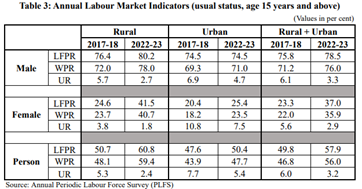Activity Status of Worker
1. Usual Principal Status (UPS)
-
- The status of activity on which a person has spent relatively longer time of the preceding 365 days prior to the date of survey is considered to be the usual principal activity status of the person.
- It is used to classify workers in/out the labour force.
- If an individual reports as having worked and sought/available for work for seven months during the year or having sought or available for work for seven months, then he/she is classified as being in the Labour Force.
Usual Principal Subsidiary Status (UPSS) or Usual Status (PS +SS)
-
- It is a more inclusive measure as compared to UPS.
- It is quite possible that one who is outside the labour force by virtue of his spending longer time on ‘neither seeking/nor being available for work’, as per UPS, might have worked for a minor time period during the yearlong reference period.
- To capture such exclusions, the concept of ‘subsidiary status worker’ was devised and thus the approach of UPSS.
- According to this approach all individuals who are either unemployed or outside the labour force but have worked for a minor period of not less than 30 days during the reference year are classified as subsidiary status workers.
2. Current Weekly Status (CWS)
-
- Reference period of 1 week (or 7 days) preceding the date of survey.
- If within the reference period, if the person is employed for even one hour during the day, he/she is considered as employed.
- It leads to a higher unemployment rate than UPS as the reference period is shorter.
3. Current Daily Status (CDS)
-
- If a person did not find work on a day or some days during the survey week, he/she is regarded as unemployed.
- Normally if a person works for four hours or more during a day, he or she is considered as employed for the whole day.
- If the person has worked for 1 to 4 hours: Half-day employed.
- The CDS method is considered to be a comprehensive measure of unemployment because it captures open unemployment (lack of opportunities), casual nature of work and thus is more broad-based.
Level of Unemployment Rate (based on the activity status chosen)
Estimation of unemployment is highest in the Current Daily Status as compared to the other to activity status.
Current Daily Status (CDS)> Current Weekly Status (CWS)> Usual Principal Status (UPS)
Periodic Labour Force Survey
Considering the importance of availability of labour force data at more frequent time intervals, National Statistical Office (NSO) launched Periodic Labour Force Survey (PLFS) in April 2017.

-
- It replaced the Employment-Unemployment Survey (EUS) which used to be conducted once every 5 years.
- PLFS is conducted annually.
- It releases two sets of data:
a) Quarterly data: For only the urban areas in the Current Weekly Status (CWS)
b) Annual data: For both rural and urban areas in both Usual Status (principal status and subsidiary status) and the Current Weekly Status (CWS)
Spread the Word
